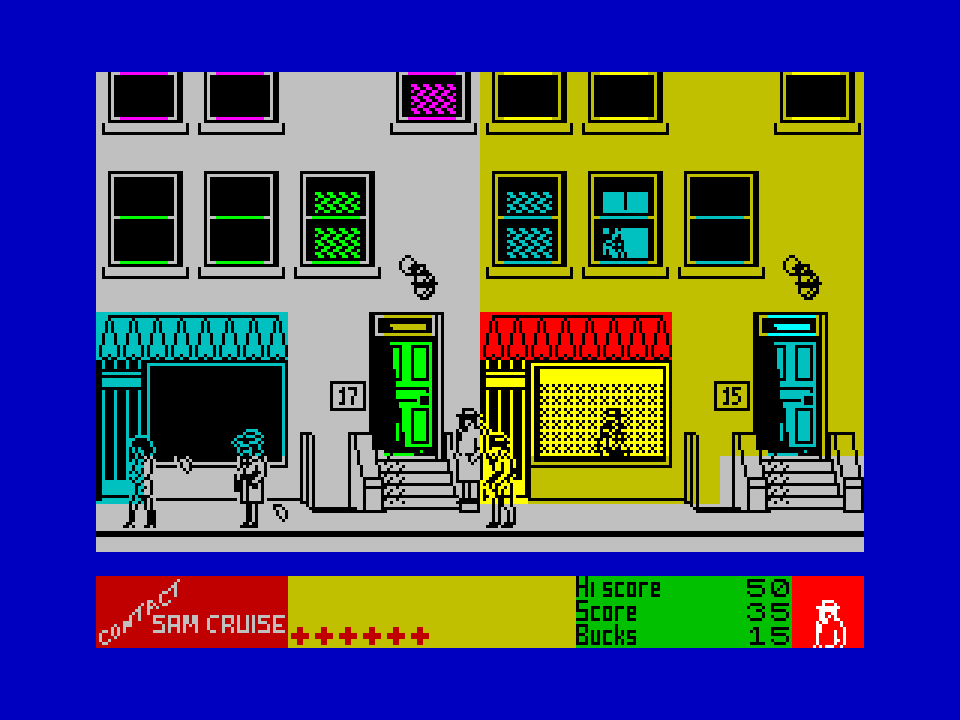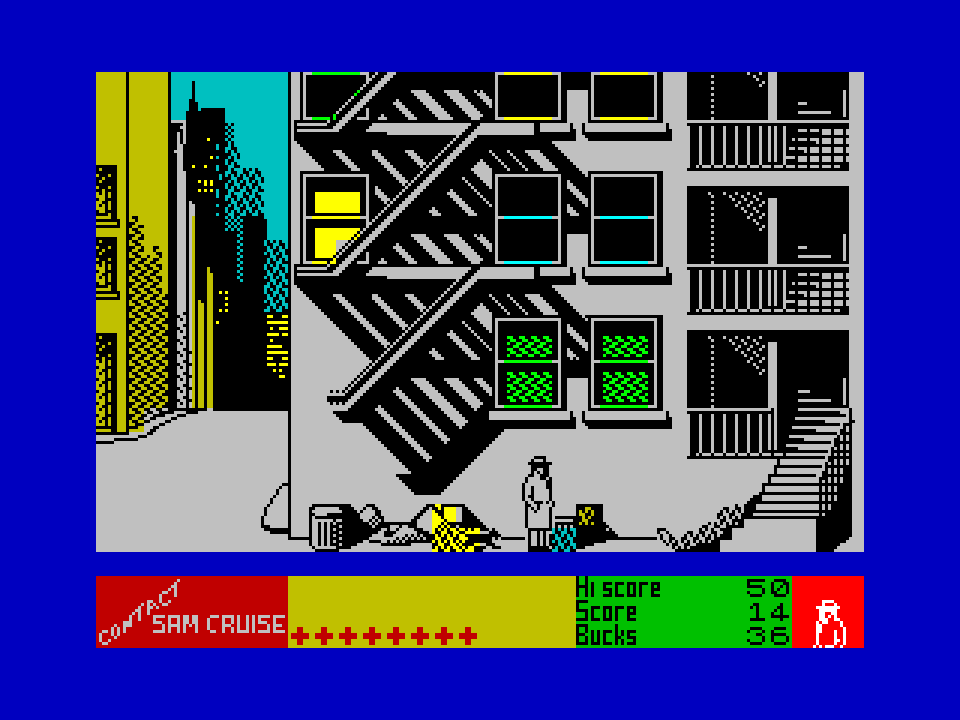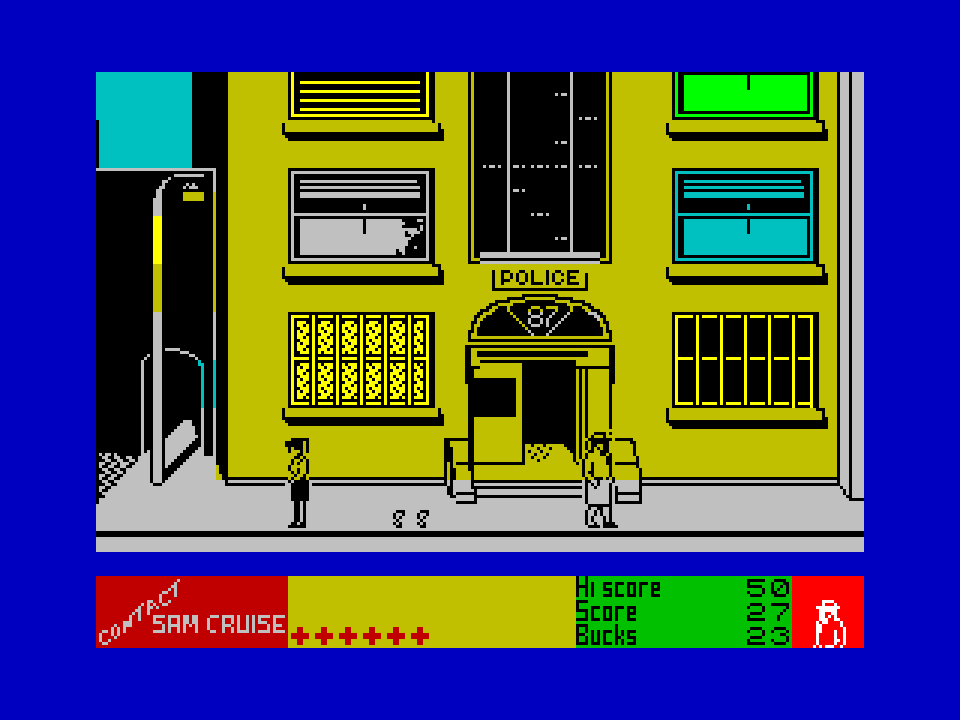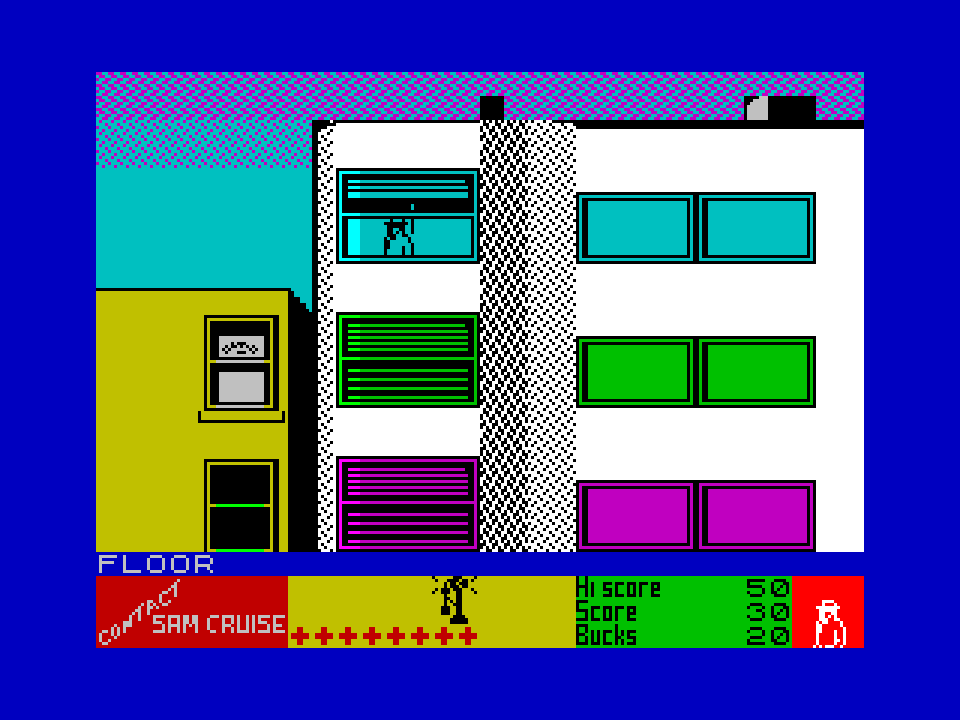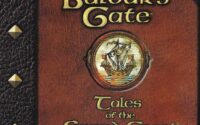Contact Sam Cruise Review
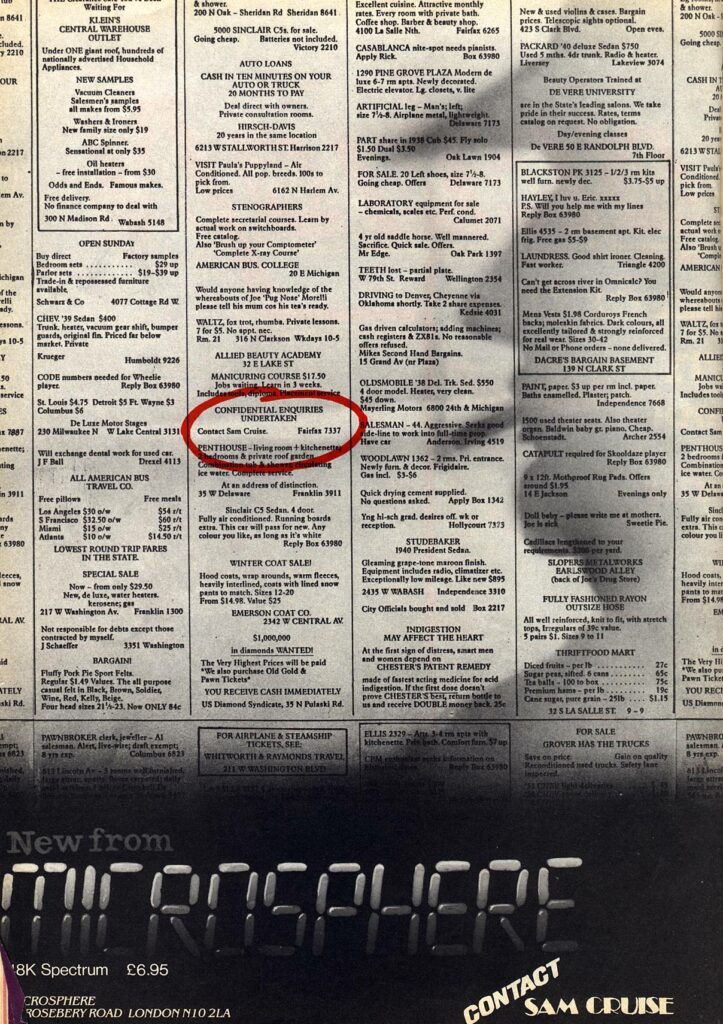
Attempt to solve a tricky and increasingly dangerous case in lovely 8-bit Game Noir-style, and dream of how good and relatively uncomplicated life felt back in Skool Daze and Back To Skool…
STORY
“Just another day at the Sam Cruise Detective Agency. I was teaching the roaches to wolfwhisle when the phone rang. It was a dame named Lana. She said to meet her on the top floor of the Hotel Royale. So began the case of the Bali Budgie.”, says the introductory on-screen text as Sam Cruise paces around in his office at no. 17, Pretty Wild Neighborhood, 2nd floor.
THE GAME
Contact Sam Cruise is the spiritual successor to Back To Skool and Skool Daze, except the classrooms and schoolyards have been replaced by a seedy street in Some Bigger U.S. City. Plus Sam is no schoolboy, but a gumshoe with bigger problems than being forced to write hundreds of lines on a blackboard. Right when the game begins, Sam is thrown head first into the case of the “Bali budgie” with nothing but 50 bucks, eight first-aid kits, and a couple of disguises. (The Fedora and the trench-coat goes without saying.)
The game takes places on an approximately ten screen-wide side-scrolling view of a couple of apartment blocks, a police station, and a hotel. (For the buildings that are taller than one screen, the view scrolls vertically.) The streets and houses are populated by various characters who mind their own business. When people enter a building, they can only be seen through the windows from the outside. That goes for Sam as well.
You control Sam and have to solve a series of more or less tricky scenarios. This involves looking for clues, talking to people, using objects, getting information, and the most dramatic part: Trying to get away from the bad guys’ extremely unwanted attention. Crack the case without losing all your money, and your secretary Daisy won’t run off with someone in the neighborhood.
CONTENT
Below the playing area are four small panels. The left one only spells the name of the game. The second (yellow) one displays your inventory, objects and items in immediate vicinity, and your first-aid kits. The third (green) window shows your score, your cash, and your Hi-score. The last one shows which disguise you’re wearing. A red background color indicates that the cops recognize you, and blue means that you haven’t been identified. All text-based information is displayed on one line between the panels and the playing area.
As you walk around, pay attention to the on-screen text and any objects that appear in the yellow window. For example, a light bulb means that you can turn off the lights wherever you are at the moment, and a door means that there is an entry or an exit for you to use.
One might otherwise think that Sam’s biggest issue is the crooks who salute him with hot lead… And it is a very big issue… But money is an even bigger one. The initial fifty bucks don’t last for long, so you need to get more from the client whom you aim to help. You can also find dollar-bills swirling around outdoors after a no doubt less successful bank robbery. Bullet wounds are treated automatically with the first-aid kids, but you are also capable of dodging bullets. When all first-aid kids are used, it’s Game Over. Pissing off baddies is one thing, but the cops can get mad too if you break into houses you’re not supposed to be in. (You do survive when some freak throws your ass off the roof of a building, but not the subsequent loss of your wallet. That’s harsh!)
CONTROLS
You might prefer to play this game using the keyboard as there are about a dozen commands apart from the directional inputs. (Walking as well as rolling and somersaulting.) Pressing “J” at any time summons the prompt: “Joystick?” Select “K” for Kempston, “I” for Interface II, “C” for cursor controls, or “N” if you don’t use any kind of Joystick interface.
Moving from place to place is done with “Q” (Up, e.g., the stairs, or away from the “camera” when you’re in the streets and exit into a building.), “A” (Down or towards the “camera”, i.e., entering from a building.), “O” (left), “P” (right), “R” (Rolling on the ground in the direction you’re facing.), and “S”. (For somersaulting.) Pressing CAPS toggles normal and fast walking. The rolling and somersaulting business isn’t merely useful for avoiding bullets, but also for grabbing the money that flies around. (There must be a reward for being able to catch paper in motion like a stunt-man with too much energy.)
But then, there are the even more useful commands when you need to escape or mislead various bastards who all might be after you. The “D”-key changes disguise, “G” picks up objects, and “B” draws or pulls blinds. (If you don’t want to be seen in a window.) With “K”, you either use a key or knock on a door, “L” turns the lights on and off in a room, “F” removes a fuse (Darkness is always a good place to hide in or for getting past people who you don’t want to bump into.), and “T” operates a telephone. (“H” is for hanging up.) You also get more telephone numbers as the story progresses. But 999 always works for calling the 5-0.
GRAPHICS
David Reidy’s and Keith Warrington’s game / design immediately became iconic with the “Skool”-games, and Contact Sam Cruise definitely takes place in the same universe. The small characters look more detailed than what seems technically possible. (There is even an extremely cute cat wandering around on the sidewalks.) While it probably is quite hard to look at the game with modern eyes, it helps a lot if you already adore the art-style of Microsphere’s proto-Sandbox games. Because they always displayed some impressive amount of details. And charm.
The choice of perspective may seem odd at first as you can’t see any of the interiors of the buildings, but the developers solved this in a clever way. If you keep moving in any direction, you are always able to spot Sam in some window or doorway. This means that he can’t vanish out of view and you not being able to figure out where he is. And simply because the focus of the gameplay is on what happens outside the apartments, you don’t need to know how the rooms in no. 19 look. The schools in the “Skool”-games didn’t famously have outer walls, but I don’t think that “doll house”-perspective would have looked nearly as good in Contact Sam Cruise.
SOUND
In the audio department, Contact Sam Cruise won’t probably please you. It’s not at all a quiet game, although it could just as well have been. As usual with the 48K system, you can’t demand much more than clicks, buzzes, and beeps. In this case however, there are also some effects that almost sound glitched. (Like when you’re hit by a bullet.) I guess it suits the moment.
SUMMARY
If you absolutely love the “Skool”-games, you should give Contact Sam Cruise a shot or ten. The games do play quite differently, and this happened to be the last of these iconic Microsphere-titles. Another Sam Cruise-game would have been much welcome. The charm, the art-style, game design, and features go a long way even when momentary frustrations kick in. But it’s easy to just get stuck exploring what the developers put in the game, and it’s equally surprising what actually fits in 48 KB… Sure, there are numerous documented bugs here, but that’s all a part of the experience, isn’t it?
“When I came to, my wallet was gone and Daisy ran off with the garbage man. Take my advice, kid. Don’t become a private eye. It’ll only break your heart.”
Poetry and solid advice. (Who Daisy runs off with, including what Sam teaches the roaches while “working on [another] case” varies from game to game.)
Note: Skool Daze was the only game in this “series” that was ported to the Commodore 64.
Developed by: David S. Reidy and Keith Warrington.
Published by: Microsphere
Version Reviewed: ZX Spectrum 48K
Genre: Adventure
Players: 1
Also Available On: N/A
Released: 1986

